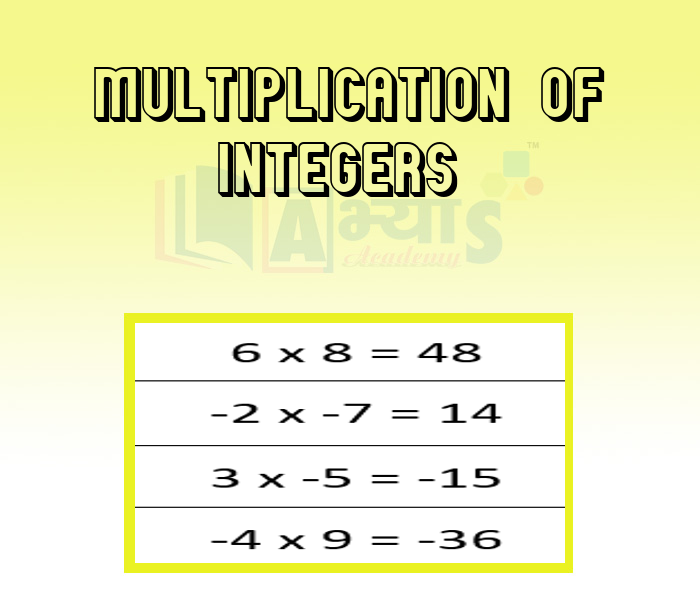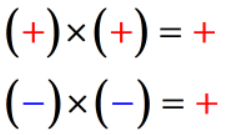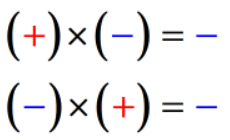Multiplication Of Integers





Multiplication Of Integers
Multiplication of Integers: The rules that govern on how to multiply and divide integers are very similar. Rules on How to Multiply Integers:


Example: Multiply the integers (+4) and (-7)
Solution: (+4) x (-7) = -28. Multiply or find the product of the absolute values (4 x 7 = 28) . Now, determine the sign of the final answer. The rule states that if the signs of the two integers are different then the final answer will be negative. Hence, -28.
Example: The opposite of ( - 2) x 7 x ( - 1 ) is __________
Solution: Multiply the absolute values (2 x 7 x 1 = 14). The product of two negative integers is positive. The opposite of 14 is (-14).
Properties of Integers under Multiplication:
Example: Verify Closure Property of (+30) by (-5).
Solution: Multiply +30 x (-5) = -150. Hence, +30, -5 and -150 are integers.
Example: Verify Commutative Property of (+10) and (-5).
Solution: Let a = +10 and b = -5. LHS = a x b = (+10) x (-5) = -50 and RHS = b x a = (-5) x (+10) = -50. Hence Verified.
Associative Property: The multiplication of integers is associative, i.e., for any three integers a, b, c, we have: a × ( b × c) = (a × b) × c.
Example: Verify Associative Property of (+9) , (-5) and (-2)
Solution: Let a = +9 , b = -5 and c = -2. LHS = a × ( b × c) = +9 x (-5 x (-2)) = +9 x (+10) = +90
and RHS = (a × b) × c = (+9 x (-5)) x (-2) = (-45) x (-2) = +90. Hence Verified.
Multiplicative Identity Property: For every integer a, we have: a × 1 = a = 1 × a. The integer 1 is called the multiplicative identity for integers. For any integer, we have a × 0 = 0 = 0 × a.
Example: Simplify: a) (-18) x 1 b) (-7) x 0
Solution: a) (-18) x 1 = (-18) b) (-7) x 0 = 0
If '/' is replaced by 'X' , then find the correct value of the following problem. (-2)/3X(-4)/1=?
| |||
| Right Option : A | |||
| View Explanation | |||
In an objective type test containing 20 questions. A student is to be awarded +3 marks for every correct answer, –2 for every incorrect answer and zero for not writing any answer. If Amit attempted 18 question correctly and 2 question incorrectly, then what is his total score? | |||
| Right Option : A | |||
| View Explanation | |||
68 x _______ = - 68 | |||
| Right Option : C | |||
| View Explanation | |||
Students / Parents Reviews [20]
Usually we see institutes offering objective based learning which usually causes a lag behind in subjective examinations which is the pattern followed by schools. I think it is really a work of planning to make us students grab the advantages of modes of examination, Objective Subjective and Onli...

Anika Saxena
8thIt was a good experience with Abhyas Academy. I even faced problems in starting but slowly and steadily overcomed. Especially reasoning classes helped me a lot.

Cheshta
10thI have spent a wonderful time in Abhyas academy. It has made my reasoning more apt, English more stronger and Maths an interesting subject for me. It has given me a habbit of self studying

Yatharthi Sharma
10thAbhyas is good institution and a innovative institute also. It is a good platform of beginners.Due to Abhyas,he has got knoweledge about reasoning and confidence.My son has improved his vocabulary because of Abhyas.Teacher have very friendly atmosphere also.

Manish Kumar
10thOne of the best institutes to develope a child interest in studies.Provides SST and English knowledge also unlike other institutes. Teachers are co operative and friendly online tests andPPT develope practical knowledge also.

Aman Kumar Shrivastava
10thWhen I have not joined Abhyas Academy, my skills of solving maths problems were not clear. But, after joining it, my skills have been developed and my concepts of science and SST are very well. I also came to know about other subjects such as vedic maths and reasoning.

Sharandeep Singh
7thAbhyas Methodology is very good. It is based on according to student and each child manages accordingly to its properly. Methodology has improved the abilities of students to shine them in future.

Manish Kumar
10thAbhyas academy is great place to learn. I have learnt a lot here they have finished my fear of not answering.It has created a habit of self studying in me.The teachers here are very supportive and helpful. Earlier my maths and science was good but now it has been much better than before.

Barkha Arora
10thIt was good as the experience because as we had come here we had been improved in a such envirnment created here.Extra is taught which is beneficial for future.

Eshan Arora
8thThird consective year,my ward is in Abhyas with nice experience of admin and transport support.Educational standard of the institute recumbent at satisfactory level. One thing would live to bring in notice that last year study books was distributed after half of the session was over,though study ...

Ayan Ghosh
8thAbhyas is a complete education Institute. Here extreme care is taken by teacher with the help of regular exam. Extra classes also conducted by the institute, if the student is weak.

Om Umang
10thAbhyas institute is one of the best coaching institute in the vicinity of Ambala Cantt area. The teachers of the institute are well experienced and very helpful in solving the problems of the students.The good thing of the institute is that it is providing extra classes for the students who are w...

Aman Kumar Shrivastava
10thIn terms of methodology I want to say that institute provides expert guidence and results oriented monitering supplements by requsite study material along with regular tests which help the students to improve their education skills.The techniques of providing education helps the students to asses...

Aman Kumar Shrivastava
10thA marvelous experience with Abhyas. I am glad to share that my ward has achieved more than enough at the Ambala ABHYAS centre. Years have passed on and more and more he has gained. May the centre flourish and develop day by day by the grace of God.

Archit Segal
7thMy experience was very good with Abhyas academy. I am studying here from 6th class and I am satisfied by its results in my life. I improved a lot here ahead of school syllabus.

Ayan Ghosh
8thMy experience with Abhyas academy is very good. I did not think that my every subject coming here will be so strong. The main thing is that the online tests had made me learn here more things.

Hiya Gupta
8thThe experience was nice. I studied here for three years and saw a tremendous change in myself. I started liking subjects like English and SST which earlier I ran from. Extra knowledge gave me confidence to overcome competitive exams. One of the best institutes for secondary education.

Aman Kumar Shrivastava
10thAbhyas is an institute of high repute. Yogansh has taken admission last year. It creates abilities in child to prepare for competitive exams. Students are motivated by living prizes on basis of performance in Abhyas exams. He is satisfied with institute.

Yogansh Nyasi
7thAbhyas institute is one of the best coaching institute in the vicinity of Ambala cantt.The institute provides good and quality education to the students.The teachers are well experienced and are very helpful in solving the problems. The major advantages of the institute is extra classes for weak...

Shreya Shrivastava
8thBeing a parent, I saw my daughter improvement in her studies by seeing a good result in all day to day compititive exam TMO, NSO, IEO etc and as well as studies. I have got a fruitful result from my daughter.
